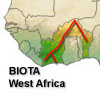Project description |
Cotton farming is known for its intensive application of pesticides as the cotton plant is very susceptible for a variety of pest species, in particular various insect species. As a consequence, insecticide application in cotton production increased by about 20% from 1993 to 2000 comprising a large diversity of insecticides.
Beside the desired effect of pest control, environmental compartments such as soil, water, crops and non-target organisms are contaminated. Biodiversity may be influenced either by direct toxic impact or by bioaccumulation of pesticides in various organisms via the food chain. Therefore, this work package aims at determining the pesticide residues in different environmental compartments and in representative indicator organisms, namely bats, amphibians, and soil arthropods which are also in the focus of WP 1a, b. The pesticide studies will be performed within and around permanent study sites (biodiversity observatories) that have been established during the current project phase in the Pendjari region.
|






 Go to the WeatherNet
Go to the WeatherNet BIOTA West Africa - Workpackage - CT2-T1-WP1c
BIOTA West Africa - Workpackage - CT2-T1-WP1c Impact of cash crop cultivation on biodiversity - Pesticide application and residues
Impact of cash crop cultivation on biodiversity - Pesticide application and residues